No. 1312 - St Helens - St Paul's Anglican Church (1870-1884)

St Helens is the largest town on Tasmania’s east coast. It was established as a fishing village and whaling station in the 1830s. When tin was discovered in the hinterland in the 1870s, St Helens was developed as a port for the mines. It was named by Captain Furneaux after a town of the same name on the Isle of Wight, England. In the 19th century the St Helens district was also referred to as Georges Bay. The history of the parish dates back to about 1862, when Rev. John Chambers, who was then in charge of the Fingal, Cullenswood, and Falmouth districts, commenced holding occasional services at St Helens. In 1867 six acres of land was granted to the Church of England “for church, burial and school purposes”. In late 1870 a weatherboard church was built on Tully Street. There is no surviving written record of the church’s opening and consecration. However this likely took place in early December 1870 when Bishop Bromby visited Goulds Country. In February 1871 a report on a meeting of th






